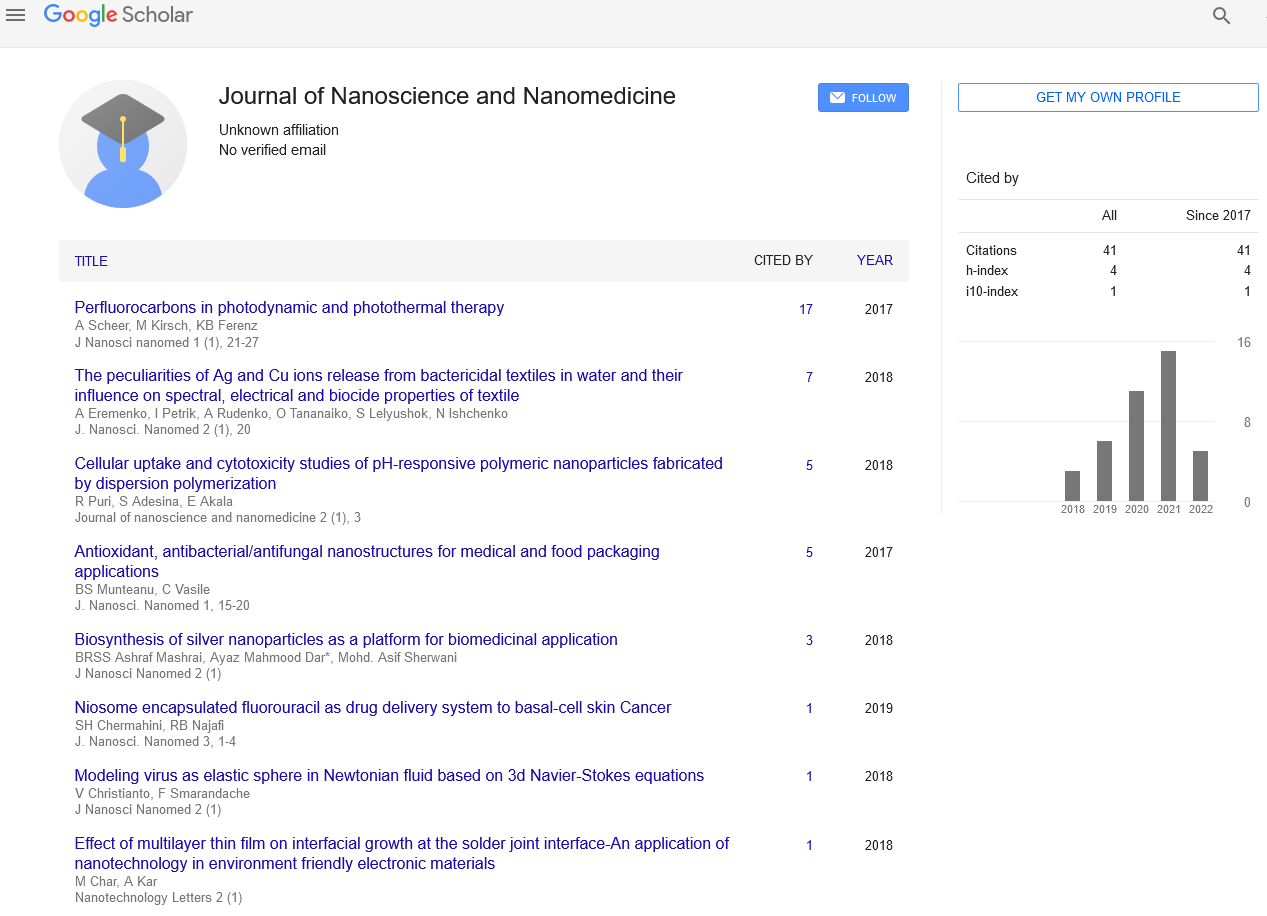Nanoparticles an Imaging Contrast in Diagnosis of Patients with Diabetes
Received: 03-Jan-2021 Accepted Date: Jan 17, 2021; Published: 25-Jan-2021
Citation: Muggu S. Nanoparticles an Imaging Contrast in Diagnosis of Patients with Diabetes. J Nanosci Nanomed 2021;5(1):3.
This open-access article is distributed under the terms of the Creative Commons Attribution Non-Commercial License (CC BY-NC) (http://creativecommons.org/licenses/by-nc/4.0/), which permits reuse, distribution and reproduction of the article, provided that the original work is properly cited and the reuse is restricted to noncommercial purposes. For commercial reuse, contact reprints@pulsus.com
Abstract
Nanotechnology-based approaches hold significant potential for making strides the care of patients with diabetes. Nanoparticles are being created as imaging differentiate specialists to help within the early conclusion of sort 1 diabetes. Diabetes mellitus could be a condition in which the body does not create sufficient of the hormone insulin, resulting in tall levels of sugar within the circulatory system. Later inquire about has appeared that diabetes can be caused by introduction to diligent natural toxins, exudates from common plastics, discuss contamination, essential and auxiliary tobacco smoke, and a few pharmaceuticals.
Introduction
Nanomedicine – the utilize of nanotechnologies to unravel restorative issues – can give promising propels to move forward the quality of life of diabetes patients. Working at the nanoscale with structures that are often 10-100 times littler than a body’s cell but as it were small, bigger than atoms make conceivable the treatment of the root of diabetes at the atomic level. For occurrence, inquire about ventures considering the conveyance of affront within the shape of nanoparticles into the nose, or into lungs as a splash, or through the gastrointestinal tract as a pill, are underway. In each case, non-invasive and easy application courses have been opened by the utilize of nanoparticles. Besides, tests are right now being conducted on nanomaterials designed with a glucose responsive coating; these can act as an affront station once infused beneath the skin. Nano-based inventive sensor frameworks are moreover beneath examination, with the objective of progressing non-invasive or less obtrusive checking of glucose level within the blood. In this respect, an even more advanced approach could be a glucose-sensitive tattoo [1].
In addition, modern safe defensive nano-coatings can drag out the survival of transplanted pancreatic islets and secure them against the autoantibodies in T1DM patients. This approach focusing on T1DM patients would permit them to involvement a life without immune-suppressive drugs. The criticalness of modern techniques to battle diabetes, which gets to be a widespread malady and leads to a critical shorter life hope (10 a long time in T2DM, >20 a long time for T1DM), and to tall costs for wellbeing frameworks, is irrefutable. Novel approaches utilizing progressed nanotechnologies can handle this societal challenge and will hence be one of the majors inquire about points in Skyline 2020, the pending EU System Program [2, 3].
Applications of nanomedicine in diabetes are in their earliest stages and none have come to schedule clinical utilize. Be that as it may, a few exceptional issues in diabetes care, such as the require for made strides glucose detecting, verbal affront definitions and transplantation of islets with improved survival, are likely to have nanomedicine arrangements and investigate is as of now exceptionally dynamic in these regions [4]. It is important at that point to consider the potential of nanomedicine from the viewpoint of a few well-described nanostructures and to demonstrate how applications of these in diabetes administration are being inquired about.
Nanoparticles for verbal affront delivery Much investigate has been performed over a long time in attempting to create a formulation of affront that's orally dynamic, hence, protecting insulin from denaturation at acidic pH within the stomach, anticipating the proteolytic corruption of affront by intestine proteins and improving the moo porousness of the digestive system to all proteins [5]. A few polymer nanoparticles joining affront have been appeared to lower blood glucose levels in creatures when managed orally, counting those comprising of biodegradable cyanoacrylate, polycaprolactone/polyacrylic polymers, casein and the polycationic polysaccharide, chitosan [6, 7]. The last-mentioned polymer is mucoadhesive and draws out home time within the intestine by authoritative the nanoparticle to the mucosa, but nanoparticles composed of chitosan and affront have moreover been found to open the tight intersections between intestine mucosal cells and progress paracellular retention of affront [7].
Conclusion
Ceramic nanoparticles such as those made of calcium phosphate, silica or alumina have the focal points of tall biocompatibility and little measure (<50 nm) and have too been examined in creature thinks about as verbal affront definitions. Other affront nanoparticles that have been tried incorporating those based on gold/chitosan and dextran–vitamin B12. In most cases, nanoparticle definitions for verbal affront conveyance have not advanced past creature testing.
REFERENCES
- Morrow KJ, Bawa R, Wei C. Recent advances in basic and clinical nanomedicine. Med Clin North Am. 2007;91:805–43.
- Nanoscience and Nanotechnologies. Royal Society and Royal Academy of Engineering, London, UK 113 (2004).
- Pickup JC, Zhi ZL, Khan F et al. Nanomedicine and its potential in diabetes research and practice. Diabetes Metab. 2008;24:604–10.
- Ariga K, Hill JP, Ji Q. Layer-by-layer assembly as a versatile bottom-up nanofabrication technique for exploratory research and realistic application. Phys Chem Chem Phys. 2007;9:2319–40.
- Zhi ZL, Haynie DT. High-capacity functional protein encapsulation in nanoengineered polypeptide microcapsules. Chem Commun. 2006;2:147–9.
- Beck J, Angus R, Madsen B et al. Islet encapsulation: strategies to enhance islet cell function. Tissue Eng. 2007;13:589–99.
- Desai TA, West T, Cohen M et al. Nanoporous microsystems for islet cell replacement. Adv Drug Deliv. 2004;56:1661–73.





